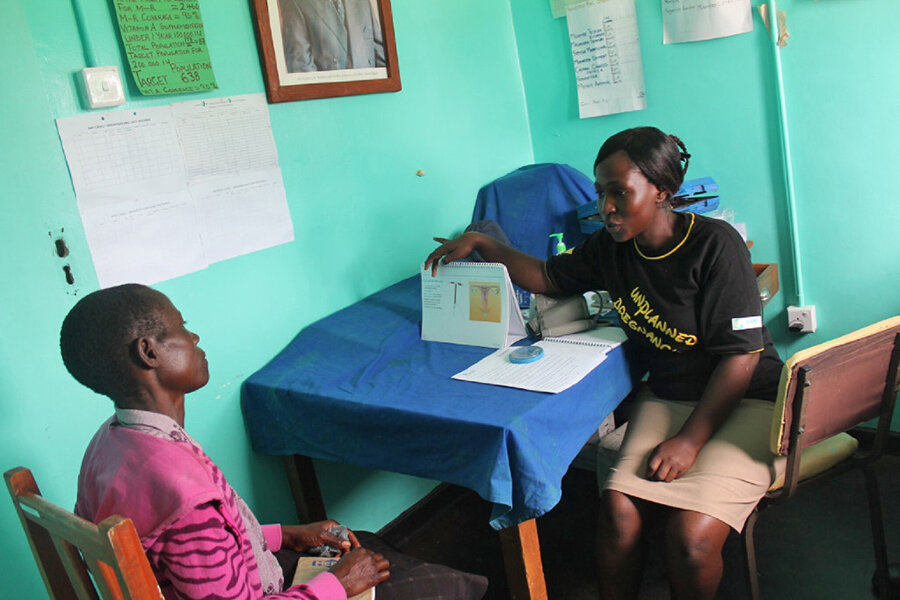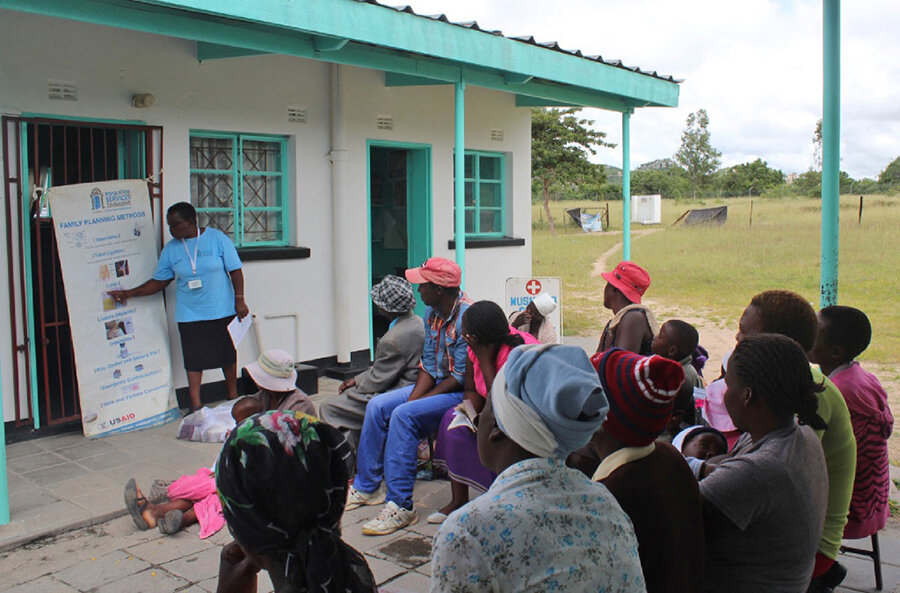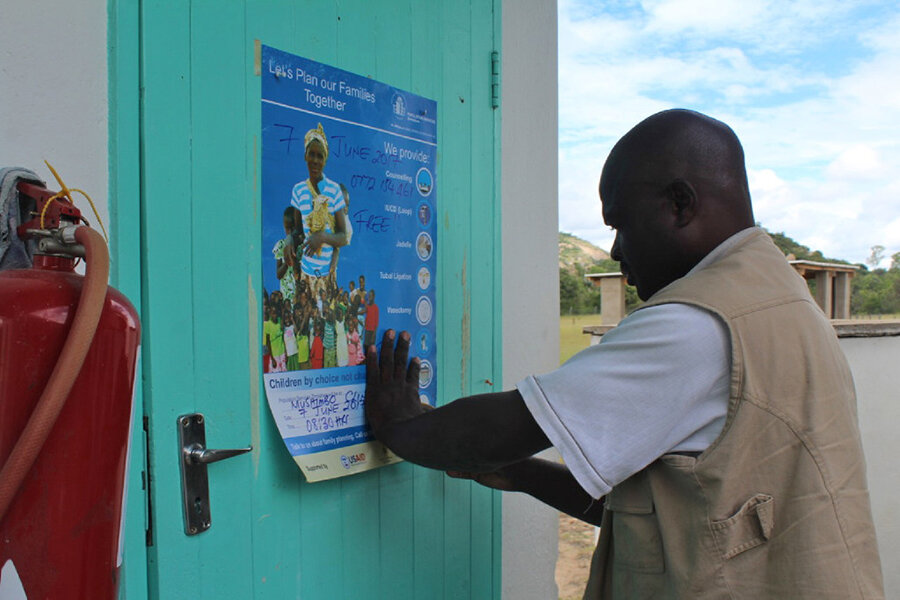As aid rules tighten under Trump, Africa's family planning clinics gear up for major gap
| Mushimbo, Zimbabwe
In this corner of rural northern Zimbabwe, the Future arrived on a Tuesday, wearing a powder-blue shirt and driving a dirt-streaked pick-up truck.
That Future, to be exact, is Future Gwena. And where she had arrived was the kind of place she spends nearly all of her days: a tiny clinic at the end of several miles of dirt road sloppy with mud and jagged rocks, a day’s walk and a week’s pay in transport costs from the nearest public hospital.
With her were a team of nurses and a trailer of rare and precious cargo – birth control, and lots of it.
“It’s up to you – we’ll give you the choices on the method, and then you will make the decision that’s best for yourself,” Ms. Gwena explained, a grin cracking across her face as she addressed a group of about 25 women – and a smattering of men – who had gathered in the clinic’s small courtyard on a recent morning.
Many jiggled cooing babies on their knees as they listened to her tick off the wide menu of free contraceptives on offer that day, from condoms to tubal ligation. The group tipped into easy laughter as women tossed out blunt questions about pros and cons of each option.
At the same moment, a near-identical scene was repeating itself at eight other sites in rural Zimbabwe. By the end of the day, Gwena and her counterparts with Population Services Zimbabwe (PSZ) – a branch of the international family-planning NGO Marie Stopes International – had offered their services to about 350 rural Zimbabwean women. Over the past four years, they’ve reached just under a half-million, according to the organization’s figures.
For women globally, such access to simple family planning services like these can be life-changing, allowing them to avoid risky pregnancies, pursue education and work, and raise smaller, better-timed families with healthier and more educated children – results well-documented by the World Health Organization and other global health bodies.
On a country level, meanwhile, the consequences of family planning access are dramatic, frequently powering dramatic reductions in maternal and infant mortality, and slowing dangerous levels of population growth. In Zimbabwe, for instance, maternal mortality has fallen by more than 30 percent since 2009, as government and donor organizations have revved up what the country director for the World Health Organization called “high impact, low cost interventions” like family planning.
But that future – and Future, too – are now working on borrowed time. Today, PSZ receives 100 percent of the funding it uses for its rural outreach programs from the US government, amounting to between $1.6 million and $2 million annually. Overall, American money accounts for 56 percent of the organization’s donor funding – which in turn is the source of most of its operating costs.
Come September, that figure will drop to 0 percent.
That is because earlier this year, President Trump revived a Reagan-era executive memorandum barring any US aid dollars from going to organizations that either “perform [or] actively promote abortion as a method of family planning,” even if those activities are funded from a different source. Most of Marie Stopes International’s money goes to other forms of family planning – indeed, in many countries, it performs no abortions at all. But its global work breaks both of the new policy’s rules.
The president’s announcement was, in many ways, no plot twist. Ever since 1973, when a Congress bitterly divided over the newly-enacted Roe v. Wade decision passed the Helms Amendment, it has been illegal to spend US aid dollars on abortion itself. But as abortion continued its ascent as a defining social issue for both Democrats and Republicans in the 1980s, then-President Ronald Reagan's administration decided it needed to go further. So in 1984, in a nod to the religious right who were his core constituency, he signed the Mexico City Policy, in virtually all cases cutting off funding to organizations that did any abortion-related work.
Ever since, the "gag rule," as the Mexico City Policy is known to its critics, has operated like a kind of partisan light switch. The prohibition was flipped off each time a Democrat took office (Clinton, Obama), then back on whenever a Republican entered the White House (Bush, Trump).
For Americans who oppose abortion, the Mexico City Policy is a more watertight way to prevent US dollars from indirectly supporting the procedure. On the ground, however, the rules may have unintended effects, critics say, as clinics choose between funding and services that they believe can be crucially important: providing information about abortions, for example, even if they don't provide the procedure themselves. And Trump's version expands the policy to include not only groups accepting USAID money earmarked for family planning – some $600 million this year – but for organizations that accept American health aid for everything from HIV to child nutrition. That aid totals about $9.5 billion.
The results of past policy swings are significant and well documented – if counterintuitive. A study published in the Bulletin of the World Health Organization in 2011, for instance, found that women in African countries that received significant USAID funding were actually more than 2.5 times more likely to have an abortion during the administration of George W. Bush – when the Mexico City Policy was in place – than during that of Bill Clinton, when it was not.
Marie Stopes International, along with the International Planned Parenthood Federation, is the largest recipient of USAID family-planning dollars. On the day Trump signed the Mexico City Policy back into law, the organization announced it would immediately stop accepting US aid money until its conditions were revoked, just as it had under Reagan and both Bush presidents. Globally, the organization estimates that the lost funding could have helped it reach 1.5 million women this year.
The impact may prove especially stark in Zimbabwe, where a decade of economic collapse has decimated the public health system, once among Africa’s best. The majority of the health sector is donor-funded, according to government officials; recently, the government even cajoled doctors and nurses to take their yearly bonus in parcels of land, since it didn’t have enough cash on hand to pay them. (They refused.)
Although priorities are shifting, family planning still ranks low in a country creaking under medical burdens that include a roughly 15 percent HIV prevalence rate and a nearly 1 in 3 chance that a child will die before turning 15.
As in many countries where Marie Stopes International operates, PSZ doesn’t actually perform any abortions in Zimbabwe. A tangle of restrictive laws and policies here make the procedure legal in only a slim minority of circumstances – and then only at a limited number of designated hospitals. (The organization does provide what it calls “abortion after-care,” free medical services for women who have had an illegal abortion elsewhere and suffered complications.)
Instead, its work largely consists of doling out birth control and family planning advice from its urban clinics and approximately 1,200 rural sites. Each site receives a visit every two or three months, and most cut a profile similar to Mushimbo, a pocket of tiny villages and homesteads huddled among the granite mountains that jut up across central Zimbabwe like chipped molars. As at most of PSZ’s sites, the majority of people here are subsistence farmers, keeping watch over tidy fields of corn, sorghum, and peanuts.
For years, their local government clinic has provided free birth control, but only short-term methods like pills or condoms, says Marvelous Gotosa, a nurse there. But she says she has long observed that many women struggled to fit taking the pill into days packed dawn to dusk with farming, cleaning, child-rearing, and cooking, or else couldn’t slip away to the clinic when they needed to restock their supply. Condoms, meanwhile, often forced unwelcome negotiations with skittish male partners.
Again and again, women showed up at her doorstep desperate for help about what to do with an unintended pregnancy – or worse, desperate for emergency medical care after they had come up with an answer to that question on their own.
In one case that still haunts her, Ms. Gotosa treated a 17-year old girl who stumbled in late at night, near death in the aftermath of a botched illegal abortion. As soon as the woman was well enough to move, however, police arrested her for undergoing the procedure.
But about five years ago, Gotosa says, things began to change.
Giving women options
One day, an SUV parked outside her gates and out poured a team of women wearing shirts that said “I am a contraceptive choice champion.” On the sleeve was a small logo reading “USAID – from the American people.” They told her they came from an NGO called Population Services, and that they were trained to provide longer-term forms of birth control, types that women would need to take just once in three or five or 10 years – or in some cases, just once for the rest of their lives.
Since then, PSZ estimates that its American aid dollars have allowed it to prevent about 138,000 unwanted pregnancies countrywide, and reduced the number of unsafe abortions in Zimbabwe by 20,400. Countrywide, meanwhile, maternal mortality dropped 36 percent between 2009 and 2014, according to the United Nations.
“Frankly, we feel this is not just about health of women – though it is very much about that. It’s also about an entire country’s development,” says Abebe Shibru, the country director of PSZ, which currently provides more than half the long-term contraceptives available in the public sector in Zimbabwe. “If we lose this program, we are going to turn back time in this country.”
Elsewhere in the region, too, many say the recent uptick in American aid for family planning means losing it now will be all the more dangerous for women here.
The problem, in part, lies with the blurry terms of the Mexico City Policy. Because many of its parameters aren’t well defined, some organizations will simply opt to avoid any work that could court controversy with the US government – like partnering with an organization that provides abortions on a project unrelated to the procedure, says Tlaleng Mofokeng, a doctor, abortion provider, and reproductive rights activist in Johannesburg.
“In South Africa, we’ve now perfected the art of gagging ourselves,” she says. After living through more than a generation of the gag rule coming and going, she says, tip-toeing around the margins of US policy has “become ingrained in us.”
Alternative donors
Globally, meanwhile, several groups have pledged to help make up the coming aid shortfall and stop the collapse of programs like PSZ’s. Lilianne Ploumen, the Netherlands’ minister for international development, pledged in January to set up a global “safe abortion fund,” and has said that she was “in talks” with more than a dozen countries, as well as private donors, about contributing.
But the task is herculean, with some $600 million to be raised in just six months if the lost US money is to be made up.
In Zimbabwe, Mr. Abebe says he’s hopeful, but also realistic.
“We don’t know if they can fill the gap,” he says. “There’s movement, but we really don’t know. In my 20 years in the aid world I’ve never seen a loss of funding so severe as this.”
Back in the procedure room in Mushimbo, Gwena – that’s Future – finishes removing a birth control implant from the arm of a woman named Grace and gently tapes a piece of gauze over the incision. After Grace has gone, Gwena shuffles around the gurney collecting leftover supplies, a smile creeping across the corners of her mouth.
Moments like this, she explains, are among the most satisfying parts of her work. Two years ago, Grace had come to her for contraception because she decided she wasn’t ready to have a child. Now she is, and so has requested her implant be removed.
“If she becomes pregnant now, it will be because that’s what she wants,” she says, “It is a choice she has made.”









